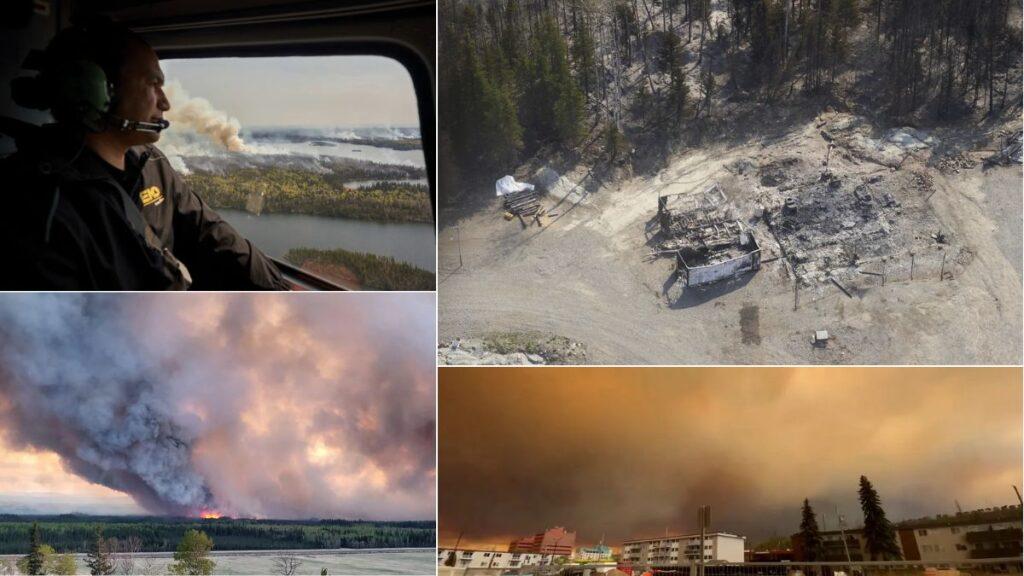Canada Wildfires: Communities flee as past fears linger due to wildfires in Canada

Improving winds and a storm moving into western Canada are providing a temporary boost to firefighters fighting massive wildfires, but the danger remains high as they burn near three communities.
Drought-stricken vegetation and days of strong winds have fueled more than 100 wildfires raging across Canada, choking the air with smoke and forcing thousands to flee since the weekend.
However, weather conditions improved midweek, assisting firefighters in their efforts to gain control of the flames.
Winds have died down in some areas and shifted in others, pushing flames away from Alberta’s Fort McMurray, which is still haunted one of Canada’s most devastating wildfires in 2016, known as “The Beast.”
A large, slow-moving storm will also pass through western and central Canada from midweek to the weekend. Cooler air from the storm will flow across the fire-ravaged provinces, raising relative humidity levels and increasing the likelihood of rain.
While Mother Nature’s assistance will not last indefinitely, any potential containment is good news for the thousands of people whose homes and businesses are at risk.
Communities Flee As Past Fears Linger On
As an out-of-control 51,000-acre wildfire crept toward Fort McMurray’s outskirts on Tuesday, roads were clogged with evacuating cars. Residents who lived through the 2016 Canada wildfires, which forced 90,000 people to evacuate and caused billions of dollars in damage to homes and businesses, remembered the approaching flames with horror.
On Tuesday, the city issued evacuation orders for the Prairie Creek, Beacon Hill, Abasand, and Grayling Terrace neighborhoods. The rest of the city and several surrounding suburbs are prepared to evacuate at a moment’s notice, because of the Canada wildfires.
Approximately 6,600 people in Alberta had been evacuated as of Wednesday, according to local officials at a news conference. Residents can expect to be away from their homes until at least May 21, according to a news release from the regional municipality.
A thick smoke veil obscured firefighters’ vision as they battled “extreme fire behavior,” according to Alberta Wildfire Information Officer Josee St-Onge. Safety concerns have led to the removal of some firefighters from the front lines.
Officials attempted to assuage the fears of residents who vividly recall the 2016 Canada wildfires, which ravaged more than 1.4 million acres and destroyed approximately 2,400 homes and businesses – the most costly natural disaster in Canadian history.
“I want to recognize the anxiety that this brings, certainly to those residents that were here in 2016, and to those where this is their first experience and have heard the stories,” Jody Butz, the regional fire chief, said. “We are confident that we have the resources to defend these areas, but we need people out of harm’s way.”
St-Onge stated on Wednesday that less than 1 millimeter of rain fell on the fire overnight. “Active fire behavior is expected today, but it should be less than yesterday, thanks to cooler temperatures and weaker winds,” she said, adding that firefighters would start establishing a containment line. According to St-Onge, 117 firefighters and 21 helicopters are currently on the scene fighting the fire.
Despite the improved weather, St-Onge warned that “a lot of work needs to be done to contain this fire, and we are still expecting high fire activity today.”
The country’s wildfire season is off to a troubling start, with new fires igniting every day and dormant so-called “zombie” fires reactivating. The 2024 fire season isn’t yet on par with last year’s record-breaking season, but as wildfire behavior worsens in a warming world, it’s no surprise that Canadian fire officials are warning of a “explosive” season that could rival last year.
Hazardous smoke from the fires has also been wafting into the United States, lowering air quality.
Degraded air quality was in effect Wednesday from the Dakotas to Oklahoma. The central US will remain the focal point for Canadian smoke until at least midweek, when it will be pushed out by an incoming storm system.
‘It is a war zone’
Multiple large fires erupted across several provinces early this week, forcing thousands of Canadians to flee their homes with children, pets, and bags stuffed with necessities and treasured possessions.
“This is a very difficult time for people who have been asked to leave their home, belongings, and community without knowing what will be there when they return,” Manitoba Premier Wab Kinew said in a statement on Tuesday.
Manitoba first responders are battling one of Canada’s largest wildfires, which has consumed at least 78,000 acres and is within a mile of the Cranberry Portage community as of Wednesday afternoon, according to the province’s media release. Over 500 people had been evacuated from the area after several neighborhoods were ordered to leave.
In British Columbia, more favorable weather conditions slowed the northeastern Parker Lake Fire’s advance toward Fort Nelson. At least 4,800 people in the area are being evacuated, including the Fort Nelson First Nation.
Rick Seidel, the owner of a local construction and trucking company, told CNN’s Canadian news partner CBC that he stayed behind to help fight the fire.
“We had all of our equipment ready, and our water trucks were loaded. “When the call came, we jumped into action,” Seidel told CBC on Monday.
“This is really bad. “It’s a war zone right now,” Seidel explained.
Climate change exacerbates wildfires
Gusty winds are driving ongoing fires in Canada, but the seeds of fire activity were sown in the winter and previous years as the world continues to warm as a result of human-caused climate change.
“This region has experienced multiple years of drought, with a below-normal snowpack this past winter,” said Ben Boghean, fire behavior specialist for the BC Wildfire Service. “As a result of this, our forests in the Fort Nelson zone are very receptive to new fire ignitions and rapid rates of spread.”
Declining snow, rising temperatures, and worsening droughts are all signs of climate change, and they are expected to fuel larger and more intense fires across Canada, according to Environment Canada.
Last year was Canada’s most devastating fire season on record, including in British Columbia, where fires destroyed hundreds of homes and an area the size of Maryland, according to the BC Wildfire Service.
The Canadian Interagency Fire Centre reports that there are over 130 fires burning across Canada, 42 of which are considered out of control.
Some of the blazes are so-called “holdover fires,” also known colloquially as “zombie fires,” which are the smoldering remains of last season’s epic blazes that burned deep in the ground throughout the winter and re-ignited when exposed to warmer temperatures in spring.
“In the past, the winter conditions are what put out a lot of holdover fires,” said Bowinn Ma, British Columbia’s minister of emergency management and climate readiness. “In this case, what we’ve seen is that due to higher temperatures and persistent drought through the last year, many of these holdover fires were not put out like they normally are.”









